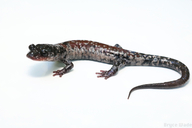|
Plethodon yonahlossee Dunn, 1917
Yonahlossee Salamander Subgenus: Plethodon | family: Plethodontidae subfamily: Plethodontinae genus: Plethodon |
 © 2020 Bryce Wade (1 of 38) |
|
|
|
Description Plethodon yonahlossee belongs to the glutinosus group of the tribe Plethodontini of lungless salamanders (Plethodontidae). There is an uncertain phylogenetic placement of P. yonahlossee within the P. glutinosus group of slimy salamanders. While P. yonahlossee is a member of the glutinosus group, it is morphologically and biochemically distinct from other members of the glutinosus or jordani complexes (Highton and Peabody 2000). Guttman et al. (1978) assigned the crevice salamander, P. longicrus, to P. yonahlossee based on morphological and allozyme evidence. However, some workers still regard P. longicrus as a distinct species due to its characteristic rocky habitat (reviewed in Petranka 1998). Distribution and Habitat Country distribution from AmphibiaWeb's database: United States U.S. state distribution from AmphibiaWeb's database: North Carolina, Virginia
Life History, Abundance, Activity, and Special Behaviors Trends and Threats Relation to Humans Possible reasons for amphibian decline Habitat modification from deforestation, or logging related activities
References
Guttman, S. I., Karlin, A. A., and Labanick, G. M. (1978). ''A biochemical and morphological analysis of the relationship between Plethodon longicrus and Plethodon yonahlossee (Amphibia, Urodela, Plethodontidae).'' Journal of Herpetology, 12, 445-454. Highton, R. and Peabody, R. (2000). ''Geographic protein variation and speciation in salamanders of the Plethodon jordani and Plethodon glutinosus complexes in the Southern Appalachian Mountains with the description of four new species.'' The Biology of Plethodontid Salamanders. R. C. Bruce, R. G. Jaeger, and L. D. Houck, eds., Kluwer Academic/ Plenum Press, New York. Petranka, J. W. (1998). Salamanders of the United States and Canada. Smithsonian Institution Press, Washington D.C. and London. Petranka, J. W., Brannon, M. P., Hopey, M. E.; Smith, C. K. (1994). ''Effects of timber harvesting on low elevation populations of southern Appalachian salamanders.'' Forest Ecology and Management, 67, 135-147. Petranka, J. W., Eldridge, M. E., and Haley, K. E. (1993). ''Effects of timber harvesting on Southern Appalachian salamanders.'' Conservation Biology, 7(2), 363-. Pope, C. H. (1950). ''A statistical and ecological study of the salamander: Plethodon yonahlossee.'' Bulletin of the Chicago Academy of Sciences, 9, 79-106. Verrell, P. A., and Mabry, M. (2000). ''The courtship of plethodontid salamanders: form, function and phylogeny.'' The Biology of Plethodontid Salamanders. R. C. Bruce, R. G. Jaeger, and L. D. Houck, eds., Kluwer Academic/ Plenum Press, New York, NY. Wake, D.B. (1966). ''Comparative osteology and evolution of the lungless salamanders, family Plethodontidae.'' Memoirs of the Southern California Academy of Sciences , 4, 1-111. Originally submitted by: Ryan Kerney (first posted 2003-01-11) Edited by: Meredith Mahoney, David Wake, and Jim Hanken (2018-12-14) Species Account Citation: AmphibiaWeb 2018 Plethodon yonahlossee: Yonahlossee Salamander <https://amphibiaweb.org/species/4162> University of California, Berkeley, CA, USA. Accessed Jun 8, 2025.
Feedback or comments about this page.
Citation: AmphibiaWeb. 2025. <https://amphibiaweb.org> University of California, Berkeley, CA, USA. Accessed 8 Jun 2025. AmphibiaWeb's policy on data use. |




 Raffaëlli Account
Raffaëlli Account Map of Life
Map of Life